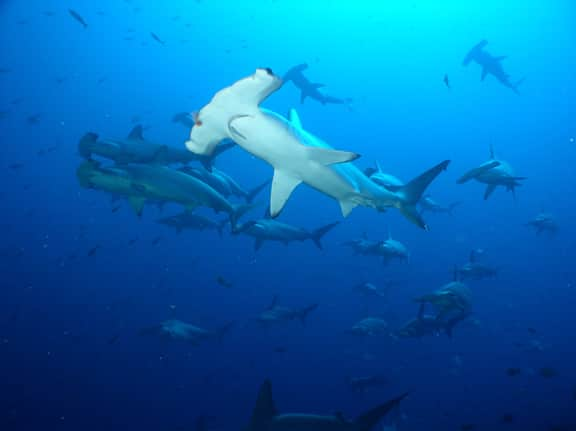Galapagos Small-Ship Cruise Operator, Ecoventura, Helps Launch Study of Effects of Galapagos Marine Reserve
OutdoorHub 01.25.13

How do the experts know if a conservation project is fulfilling its goals?
This is the question posed by scientists of the Galapagos Science Center and the Galapagos community concerning the Galapagos Marine Reserve established in 1998 on a provisional basis because at the time there was a lack of scientific information on the local biodiversity.
Fourteen years later, a barometer of the reserve’s success is how well – or not – the sharks are doing.
Ecoventura (http://www.ecoventura.com), that operates an environmentally friendly fleet of small expedition yachts in the Galapagos Islands, a UNESCO World Heritage Site, recently volunteered one of its four yachts, The M/V Galapagos Sky, a live-aboard dive boat, to participate in the beginning phase of a shark conservation analysis that engaged the ship in late December and early January 2013. The goal moving forward is to gather data on the diversity, abundance and distribution of focal species. The data will help guide the design of a new zoning scheme for the reserve based on determinations of spatial extensions of key habitats for Galapagos’ flagship species, including sharks. Elasmobranchs (sharks and rays) are top predators and keystone species in their ecosystems and therefore serve as sentinels for the general health of the ecosystem and its community.
In January 2012, the shark acoustic telemetry project outlined plans to begin working with the Galapagos Science Center and the Galapagos National Park to investigate habitat use and movement patterns of juvenile Blacktip sharks. The research project is calling on local volunteer professionals, including students, who in turn will educate and facilitate next-generation biologists and conservationists. The resulting data is expected to reveal where Blacktip sharks migrate alter leaving their nursery grounds and where and how extensive the nursery habitats are in the Galapagos Marine Reserve.
Scientists concurrently, using underwater photo and video equipment, will be studying, among others, the impacts of humans on sea turtle populations and the abundance and distribution of cetaceans (whales and dolphins).
A spokesperson for Ecoventura, Doris Welsh, said that guests on board with the scientists “shared a high interest in conservation issues and research projects. Divers were happy to know that by booking with the Galapagos Sky they indirectly supported conservation projects in the Galapagos Islands, through Ecoventura’s collaborations and through their park entrance fees.” Welsh noted that research findings are still being analyzed.
The principal scientific investigator is Maximilian Hirschfeld working with collaborating researchers Leandro Vaca Pita, Juan Pablo Munoz Perez and Jens Mayorga Molina.

